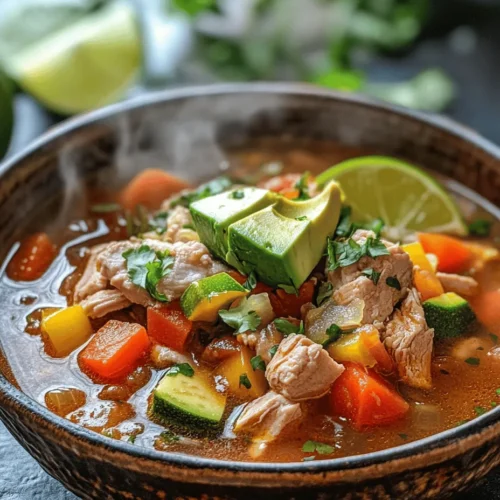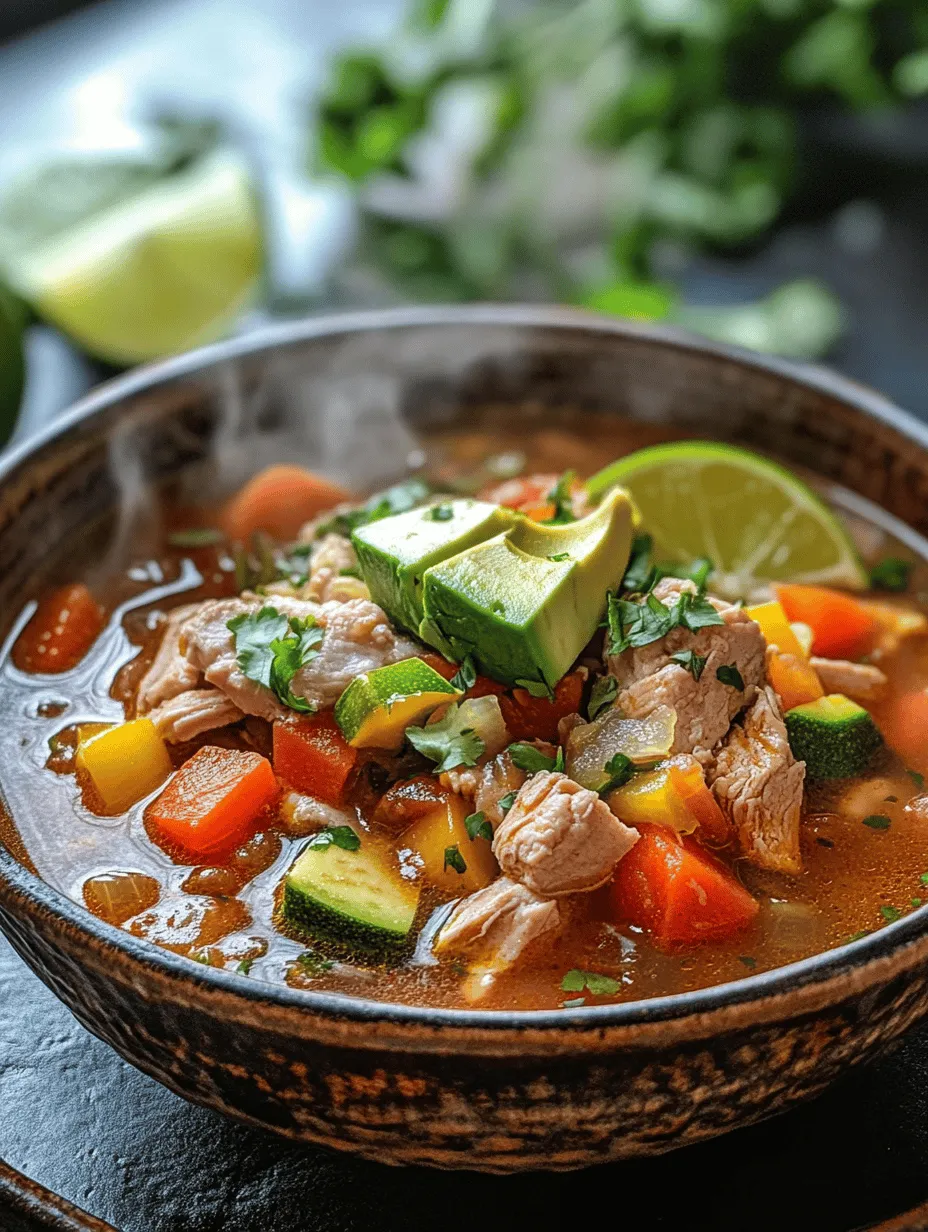Introduction to Southwest Chicken Soup: A Flavorful Journey
When it comes to comforting meals that warm the soul, few dishes can rival a steaming bowl of Southwest Chicken Soup. This delightful recipe is more than just a meal; it’s a flavorful experience that captures the vibrant essence of Southwestern cuisine. Imagine tender chicken simmered to perfection, mingling with a variety of nutritious vegetables, and enveloped in a harmonious blend of spices that transport you to the sun-drenched deserts of the American Southwest. Whether you’re seeking solace on a chilly evening or looking to impress guests at a cozy gathering, this soup is bound to become a staple in your culinary repertoire.
The roots of this dish are steeped in a rich history of cultural influences, drawing from the Native American, Spanish, and Mexican traditions that converge in this unique region. Each bowl of Southwest Chicken Soup tells a story, not just of the ingredients, but of the communities that have embraced them for generations. In this article, we’ll delve into the historical significance of Southwestern cuisine, explore the health benefits of the ingredients that go into this soup, and provide you with a detailed step-by-step guide to creating this comforting dish in your own kitchen.
Exploring Southwestern Cuisine: A Cultural Melting Pot
The Roots of Southwestern Flavors
The flavors of the Southwest are a vibrant tapestry woven from the diverse culinary traditions of its indigenous peoples, early Spanish settlers, and later Mexican influences. This fusion has given rise to a distinctive cuisine characterized by bold flavors, unique ingredients, and a celebration of communal eating.
Historical Influences: Native American tribes were the original inhabitants of the Southwest, cultivating crops such as corn, beans, and squash, often referred to as the “Three Sisters.” These staple ingredients provided the foundation for a diet rich in nutrients and flavor. When Spanish colonizers arrived, they introduced new ingredients, including livestock, dairy products, and various spices. The incorporation of these elements laid the groundwork for what we now recognize as Southwestern cuisine.
Signature Ingredients: At the heart of Southwestern cooking are ingredients that define its bold flavors. Chili peppers, both fresh and dried, are ubiquitous, adding varying degrees of heat and complexity to dishes. Corn, in its many forms, is a staple, whether it’s used as a base for tortillas, in soups, or as a side dish. Black beans and pinto beans also play a crucial role, providing protein and fiber, while fresh vegetables contribute to both nutrition and texture.
The Essence of Comfort Food in the Southwest
In many cultures, comfort food reflects a sense of belonging and identity. In the Southwest, dishes like Southwest Chicken Soup are more than just sustenance; they are a source of warmth and community.
How Comfort Food Reflects Cultural Identity: The act of gathering around a pot of soup transcends mere nourishment. It is an invitation to share stories, laughter, and love. In Southwestern households, soups are often prepared in large batches, allowing family and friends to come together and enjoy the rich flavors that resonate with their heritage.
The Role of Soup in Communal Gatherings: Soup serves as a centerpiece for many communal meals throughout the Southwest. Whether it’s a family dinner, a neighborhood potluck, or a festive celebration, a hearty pot of Southwest Chicken Soup brings people together, fostering connection and warmth.
Ingredients Breakdown: What Makes This Soup Special
A closer look at the ingredients that make up Southwest Chicken Soup reveals the care and thought that goes into creating this flavorful dish. Each component is chosen not only for taste but also for the nutritional benefits it brings to the table.
Key Components of Southwest Chicken Soup
1. Fresh Vegetables: The foundation of any great soup lies in its vegetables. In this recipe, we’ll use a medley of onion, bell pepper, carrots, and zucchini. These fresh ingredients not only provide essential vitamins and minerals but also add color and texture, making each bowl visually appealing.
2. Protein Source: Boneless, skinless chicken breasts are the star of this soup. They are lean, packed with protein, and become tender as they simmer, enhancing the overall flavor of the dish. Additionally, chicken is a versatile protein that pairs beautifully with the spices and vegetables in this recipe.
3. Flavor Enhancers: No soup is complete without aromatics, and in this case, garlic and a variety of spices and herbs elevate the overall flavor profile. Cumin, paprika, and oregano are just a few of the spices that create the depth of flavor characteristic of Southwestern cuisine.
Nutritional Profile of Each Ingredient
Understanding the nutritional benefits of the ingredients in Southwest Chicken Soup can help you appreciate this dish even more.
– Health Benefits of Chicken and Beans: Chicken is an excellent source of lean protein, essential for muscle repair and growth. Adding black beans or pinto beans to the soup not only boosts the protein content but also provides fiber, which is crucial for digestive health.
– Importance of Vegetables in a Balanced Diet: The inclusion of fresh vegetables in this soup ensures you’re getting a variety of vitamins and minerals. For example, bell peppers are rich in vitamin C, while carrots provide beta-carotene, an antioxidant that supports eye health.
– Spices: Not Just Flavor, But Health Benefits: The spices used in this soup do more than enhance flavor; many have health-promoting properties. For instance, cumin has been shown to aid digestion, while paprika contains antioxidants that can help combat inflammation.
Cooking Process: Step-by-Step to Flavorful Perfection
Now that we’ve explored the vibrant history and nutritional benefits of Southwest Chicken Soup, let’s dive into the cooking process. This section will guide you through the essential steps to create a mouthwatering soup that you and your loved ones will crave.
Sautéing the Aromatics: Building the Base Flavor
The first step in crafting your Southwest Chicken Soup is to build a robust flavor base. Sautéing the aromatics is a crucial part of this process.
– Importance of Onion and Garlic in Cooking: Onions and garlic form the backbone of many dishes, including soups. They release their natural sugars and flavors when sautéed, creating a savory base that enhances the overall profile of the soup.
– Tips for Achieving the Perfect Sauté: Start by heating a few tablespoons of olive oil in a large pot over medium heat. Once the oil is shimmering, add your diced onions and minced garlic. Sauté for about 3-5 minutes, stirring occasionally until the onions become translucent and fragrant. Be careful not to burn the garlic, as it can impart a bitter taste to the dish.
Incorporating Vegetables: A Colorful Addition
With your aromatics perfectly sautéed, it’s time to add the rest of the vegetables. This step not only enriches the flavor but also adds visual appeal and nutritional value to your soup.
– Adding Fresh Vegetables: Dice your bell peppers, carrots, and zucchini, and add them to the pot. Stir them in with the sautéed onions and garlic. Allow them to cook for an additional 5-7 minutes until they begin to soften, stirring occasionally to prevent sticking. The vibrant colors of the vegetables will brighten the dish, making it even more inviting.
Continue with the recipe by adding the protein and spices, and you’ll soon find yourself on the way to creating a comforting and flavorful Southwest Chicken Soup that embodies the spirit of the Southwest. Stay tuned for the next part, where we will delve deeper into the cooking process and explore more tips for achieving the perfect bowl of soup.

Benefits of Adding a Variety of Vegetables
Incorporating a diverse array of vegetables into your Southwest Chicken Soup not only enhances its flavor but also boosts its nutritional value. Vegetables like bell peppers, carrots, zucchini, and corn add vibrant colors and textures, making the soup visually appealing and wholesome. Each vegetable contributes unique vitamins and minerals; for instance, bell peppers are rich in vitamin C, while carrots provide beta-carotene for eye health. Moreover, the variety of textures from crunchy to soft creates a delightful eating experience, ensuring that every spoonful is packed with health benefits.
Additionally, using seasonal vegetables can make your soup even more flavorful and fresh. When you opt for ingredients that are locally sourced and in season, you support local agriculture and reduce your carbon footprint. This approach not only enhances the taste but also promotes a sustainable cooking practice that is beneficial for both you and the environment.
Techniques for Ensuring Even Cooking
When preparing Southwest Chicken Soup, ensuring that all ingredients cook evenly is essential for achieving the best flavor and texture. Start by chopping your vegetables into uniform pieces; this allows them to cook at the same rate. For instance, if you’re using carrots, cut them into thin rounds or small cubes to ensure they soften properly without becoming mushy.
When sautéing your vegetables, begin with the densest ones, such as onions and carrots, which take longer to cook. Follow up with quicker-cooking vegetables, like bell peppers and zucchini. This technique guarantees that each ingredient reaches its ideal tenderness while retaining its distinct flavor.
Cooking the Chicken: Achieving Tenderness
Best Practices for Browning Chicken
The chicken is the star of your soup, and achieving a perfect sear is key to building a rich flavor base. Start by using a heavy-bottomed pot or Dutch oven. Heat a tablespoon of oil over medium-high heat until shimmering, then carefully add your chicken pieces in a single layer. Avoid overcrowding the pot; this will steam the chicken instead of searing it. Allow the chicken to cook undisturbed for several minutes until it develops a golden-brown crust. Flip it over and brown the other side, which should take another few minutes.
Remember, the browning process not only enhances the flavor through the Maillard reaction but also creates fond (the brown bits stuck to the bottom of the pot) that will enrich your soup.
The Significance of Seasoning at This Stage
Seasoning your chicken during the browning process is crucial for infusing flavor early on. A simple sprinkle of salt and pepper is essential, but you can enhance the flavor profile by using spices like paprika, cumin, or chili powder. These seasonings will permeate the chicken as it cooks, laying the groundwork for the flavor development of your entire soup.
Creating the Soup Base: Blending Flavors
The Role of Chicken Broth and Tomatoes in Soup
The foundation of your Southwest Chicken Soup is its broth, which serves as the liquid base that melds the flavors of all ingredients. Using high-quality chicken broth will elevate your soup significantly. If possible, opt for low-sodium broth; this allows you to control the salt levels as the soup simmers.
Fresh or canned tomatoes also play a pivotal role in the soup’s base. They add acidity, sweetness, and depth. When using canned tomatoes, consider crushed or diced varieties for a smoother texture. If you prefer fresh tomatoes, ensure they are ripe and flavorful; this will enhance the overall taste of your soup.
How to Balance Flavors with Spices
Balancing flavors is an art that can elevate your soup from good to exceptional. Start by adding spices like cumin, coriander, and oregano to the broth and tomatoes to create a warm, earthy flavor base. A pinch of cayenne or chili powder can add a kick, while lime juice brightens the overall dish with acidity.
Taste as you go, adjusting the spices and acidity to suit your preference. Remember, the goal is to complement the chicken and vegetables, creating a harmonious blend of flavors.
Simmering: The Key to Flavor Development
Why Simmering is Crucial for Soup Making
Simmering is the heart of soup-making, allowing all the flavors to meld together beautifully. Once you’ve added your broth and tomatoes to the pot, bring the mixture to a gentle boil, then reduce the heat and let it simmer. This process allows the chicken to become tender and the vegetables to soften while releasing their flavors into the broth.
Simmering also helps to concentrate the flavors, resulting in a rich and satisfying soup. For optimal results, let your soup simmer for at least 20-30 minutes, but if time permits, longer simmering will only enhance the flavor.
Tips for Achieving the Right Consistency
The consistency of your soup can greatly affect the overall experience. If your soup appears too thick, gradually add more broth until you reach your desired consistency. Conversely, if it’s too thin, let it simmer uncovered for a bit longer to allow some of the liquid to evaporate and thicken the soup.
For a creamier texture, consider blending a portion of the soup with an immersion blender before serving. This technique will enrich the broth without losing the delightful chunks of chicken and vegetables.
Final Taste Adjustments: Perfecting Your Creation
How to Taste and Adjust Seasonings Effectively
Taste testing is an essential step in cooking, especially for soups. Once your soup has simmered, take a moment to taste it. Pay attention to the balance of flavors; you may want to add more salt, pepper, or spices depending on your preference. If the soup is too salty, a splash of vinegar or squeeze of lime can help cut through the saltiness, balancing the flavors.
Always remember to taste throughout the cooking process, adjusting seasonings as necessary. This ensures that you create a soup that is finely tuned to your palate.
Importance of Personal Preference in Flavor Profiles
Each person has different taste preferences, so it’s essential to consider who you’re serving. If you’re cooking for a group, providing toppings like sour cream, lime wedges, or hot sauce allows everyone to customize their bowl according to their taste. This way, you can cater to a variety of flavor profiles while still enjoying the same base soup.
Serving Suggestions: Elevating Your Soup Experience
Garnishing with Fresh Ingredients
Presentation plays a significant role in the enjoyment of any dish. Garnishing your Southwest Chicken Soup with fresh cilantro and a squeeze of lime can elevate its aesthetic appeal and flavor profile. Cilantro adds a burst of freshness, while lime juice enhances the dish with a zesty kick.
Consider adding optional toppings such as diced avocado. Avocado not only provides a creamy texture but also contributes healthy fats, making your soup even more satisfying.
Pairing with Sides: What Complements Your Soup?
The right sides can enhance your soup experience. For a comforting pairing, serve the soup alongside warm cornbread, which complements the Southwestern flavors beautifully. Tortillas, either crispy or soft, are another excellent option, perfect for dipping.
For a more substantial meal, consider a side salad with a light vinaigrette to balance the richness of the soup. Beverages such as iced tea, a light lager, or even a fruity white wine can round out your meal, making it unforgettable.
Conclusion: Embrace the Comfort of Southwest Chicken Soup
In conclusion, Southwest Chicken Soup is a quintessential dish that brings warmth and comfort to any table. Its blend of fresh ingredients, spices, and the love put into its preparation is what makes it a beloved choice for many. By understanding the cultural significance, nutritional benefits, and cooking process behind this recipe, you can appreciate each bowl you serve.
Whether it’s for a family dinner or a gathering with friends, this soup is sure to satisfy and delight. The process of making this dish creates not only a wonderful meal but also cherished memories shared around the table. Enjoy the journey of making and sharing this flavorful dish, and let each spoonful remind you of the love and care that goes into cooking.


